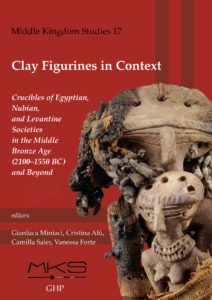Si segnala l’uscita del 17° volume della collana “Middle Kingdom Studies”, diretta da Gianluca Miniaci (Università di Pisa) e pubblicata da Golden House Publications:
“Clay Figurines in Context: Crucibles of Egyptian, Nubian, and Levantine Societies in the Middle Bronze Age (2100–1550 a.C.) and Beyond”, a cura di Gianluca Miniaci, Cristina Alù, Camilla Saler e Vanessa Forte. ISBN 978-1-906137-86-1
Il volume presenta i risultati della conferenza “Clay Figurines in Context: miniatures as crucibles of Nile Valley societies in the Second Millennium BC (Egypt and Nubia)”, tenutasi a Pisa il 17-18 ottobre 2022 nell’ambito del progetto PROCESS – “Pharaonic Rescission: Objects as Crucibles of Ancient Egyptian Societies”. Oltre agli atti della conferenza, il volume è stato ampliato con contributi di autori invitati.
La pubblicazione è stata finanziata dal programma PRIN 2017 (codice progetto 201758TWK5), Ministero dell’Università e della Ricerca (MUR), nell’ambito del progetto PROCESS – “Pharaonic Rescission: Objects as Crucibles of Ancient Egyptian Societies”.
 Sin dalla preistoria, in Egitto sono state realizzate figurine raffiguranti esseri umani, animali e altri soggetti in diversi materiali. Le figurine in ceramica o argilla sono ancora un ambito non del tutto esplorato, a causa della percezione del loro scarso valore materiale e della variabile conservazione dovuta alla loro composizione organica. Nonostante ciò, le figurine di argilla offrono uno sguardo unico sulle idee, gli usi e le attitudini degli antichi, soprattutto quando modellate a mano. La loro diffusione, malleabilità e portabilità le rendevano accessibili a persone di ogni classe economica e sociale. Il volume verte su figurine di argilla egizie del Medio Bronzo (ca. 2100-1550 a.C.) e include anche esempi provenienti dai paesi vicini, come la Nubia e il Levante, in quanto partner più immediati in termini di diffusione e commistione culturale. I saggi contenuti in questo volume si propongono di esplorare temi poco studiati o completamente nuovi riguardo alle figurine di argilla, come il loro contesto archeologico, le tecniche di fabbricazione, i processi tecnologici, la classificazione, l’agency e il significato sociale. Inoltre, due sezioni del volume saranno dedicate al confronto con materiali comparativi del IV e III millennio a.C. e del tardo Bronzo.
Sin dalla preistoria, in Egitto sono state realizzate figurine raffiguranti esseri umani, animali e altri soggetti in diversi materiali. Le figurine in ceramica o argilla sono ancora un ambito non del tutto esplorato, a causa della percezione del loro scarso valore materiale e della variabile conservazione dovuta alla loro composizione organica. Nonostante ciò, le figurine di argilla offrono uno sguardo unico sulle idee, gli usi e le attitudini degli antichi, soprattutto quando modellate a mano. La loro diffusione, malleabilità e portabilità le rendevano accessibili a persone di ogni classe economica e sociale. Il volume verte su figurine di argilla egizie del Medio Bronzo (ca. 2100-1550 a.C.) e include anche esempi provenienti dai paesi vicini, come la Nubia e il Levante, in quanto partner più immediati in termini di diffusione e commistione culturale. I saggi contenuti in questo volume si propongono di esplorare temi poco studiati o completamente nuovi riguardo alle figurine di argilla, come il loro contesto archeologico, le tecniche di fabbricazione, i processi tecnologici, la classificazione, l’agency e il significato sociale. Inoltre, due sezioni del volume saranno dedicate al confronto con materiali comparativi del IV e III millennio a.C. e del tardo Bronzo.
English version
We are pleased to announce the publication of the 17th volume in the “Middle Kingdom Studies” series, edited by Gianluca Miniaci (University of Pisa) and published by Golden House Publications:
“Clay Figurines in Context: Crucibles of Egyptian, Nubian, and Levantine Societies in the Middle Bronze Age (2100–1550 BC) and Beyond”, edited by Gianluca Miniaci, Cristina Alù, Camilla Saler, and Vanessa Forte. ISBN 978-1-906137-86-1
The volume presents the results of the conference “Clay Figurines in Context: miniatures as crucibles of Nile Valley societies in the Second Millennium BC (Egypt and Nubia)”, held in Pisa on October 17-18, 2022, as part of the PROCESS project – “Pharaonic Rescission: Objects as Crucibles of Ancient Egyptian Societies”. In addition to the conference proceedings, the volume has been expanded with contributions from invited authors.
The publication was funded by the PRIN 2017 program (project code 201758TWK5), funded by the Italian Ministry of University and Research (MUR), as part of the PROCESS project – “Pharaonic Rescission: Objects as Crucibles of Ancient Egyptian Societies”.
Further information at http://www.goldenhp.co.uk/index2.htm
Since prehistory, ancient Egyptians crafted figurines depicting humans, animals, and other subjects. However, scholars have largely overlooked the category of clay figurines, both fired and unfired, due to the perceived lack of value of the material and variable preservation of their organic material composition. Despite this, clay figurines offer a unique glimpse into ancient peoples’ ideas, gestures, and attitudes, particularly when shaped by hand. Their prevalence, malleability, and portability make them accessible to people of all economic and social backgrounds. This volume focuses on Egyptian clay figurines from the Bronze Age, ranging from approximately 2100 to 1550 BC, and also includes examples from the neighboring countries of Nubia and the Levant, as they are the most immediate corresponding partners in terms of diffusion and entanglement of material culture. The papers in this volume aim to examine previously under- or unexplored topics relating to clay figurines, such as their archaeological context, manufacturing techniques, technological processes, classification, agency, and social significance. Additionally, two sections of the volume will be dedicated to comparative material from the 4th and 3rd millennium BC and the Late Bronze Age.


